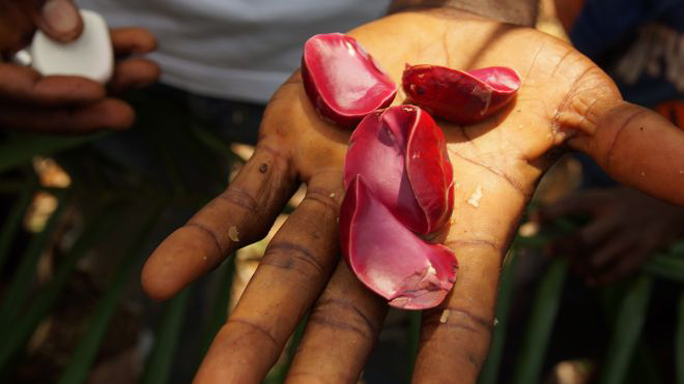Kola Nut
It used to be that synthetic glidants, petrochemical emulsifiers and polymer beadlets took the lead in the cosmetic ingredient world. Chemical science led the way for cosmetics, and petroleum provided a plethora of ingredients for skin and hair care. But those days are fading fast, as a whole new range of older ingredients are becoming trendier – and much more in demand.
Pure plant extracts and botanical concentrates have taken center stage at this year's “In Cosmetics” exposition in Paris, where companies like Estée Lauder, L'Oreal, Beiersdorf and hundreds of other name brands are currently scouring the exhibits looking for beauty magic. The luster of chemical ingredients appears to have faded, and the glow is on for botanicals that enhance skin, improve hair health, and actually boost youthful appearance.
The chemical companies are still displaying their wares, and the booths run by chemical giants like Dow and BASF are large and impressive. But dozens of plant-based suppliers are finding their booths filled to overflowing, as cosmetic company formulators, chemists, marketing managers and innovation specialists seek the latest herbal cosmetic trends.
African botanicals seem to be in the lead this year, and savvy buyers have their choice of various suppliers of shea butter – a silky cream base that already is enjoying explosive growth in lotions and creams worldwide. Kigelia, also known as ‘sausage tree,’ yields a funny-looking elongated fruit that is capturing attention for its soothing and antibacterial properties. Used traditionally in Mozambique for wound healing, kigelia is heading for the cosmetic center stage as leading global brands are pondering its uses in upcoming formulations.
Surprisingly, three botanicals used widely in the beverage business are finding new life in skin preparations. Unroasted green coffee from West Africa demonstrates anti-aging and skin firming properties, and it also helps to promote the growth of new, healthy-looking skin. This activity, largely due to a group of compounds called chlorogenic acids, is of keen interest to formulators of new cosmetic potions. So expect coffee to show up on your night cream ingredient list soon.
Kola nut, the same material used in cola soft drinks, has anti-cellulite properties and shows value in reducing puffiness and dark circles under the eyes. Look for kola down the road in cellulite creams and eye care formulas.
The South African tea rooibos is being promoted for its anti-aging properties for skin and its ability to help protect against sun damage. Expect to see rooibos in your summer sun protection products.
The thick, rubbery variety of hibiscus known as roselle not only makes a great-tasting tea, but scientific studies show that the extract of this deep reddish purple blossom from Burkina Fasso has anti-inflammatory properties and is perfect in preparations for sensitive skin. The deep red of this plant also makes it a good natural colorant. Different from the regular ornamental hibiscus, roselle, with its thick, rubbery leaves, is now widely cultivated – specifically for inclusion in body care products.
Walking the aisles of this year's “In Cosmetics” exposition, I came across novel cosmetic oils from the Amazon, fragrant essential oils from Nepal, and Kampo traditional herbal skin formulas from Japan – all prepared in forms that make them ideal for use in cosmetic, skin and hair care products. Even exotic mushrooms are being promoted for use in facial creams, to make skin young and supple.
Where once laboratory chemistry appeared to reign supreme, nature is re-establishing dominance – but with a strong scientific backup. Today's portfolios of herbal ingredients come with dossiers of scientific substantiation, charts showing their chemistry, and even samples as examples of how these ingredients can be formulated into finished products.
An additional strong theme at “In Cosmetics” is the demand for sustainability. The big cosmetic companies not only want their ingredients increasingly natural, but they are demanding sourcing that follows strict guidelines of ethical trade and environmental preservation. Ingredient suppliers who haven't yet caught on to the demand for sustainable ingredients are standing in largely empty booths.
At “In Cosmetics,” what is old is new again. Plants of all kinds yield compounds that firm skin, reduce wrinkles, make hair shine, diminish cellulite, and enhance beauty in hundreds of ways. For you, that means cleaner, safer cosmetic and body care products, less toxic waste, and perhaps even a healthier environment in the long run. And that is a very beautiful thing.


